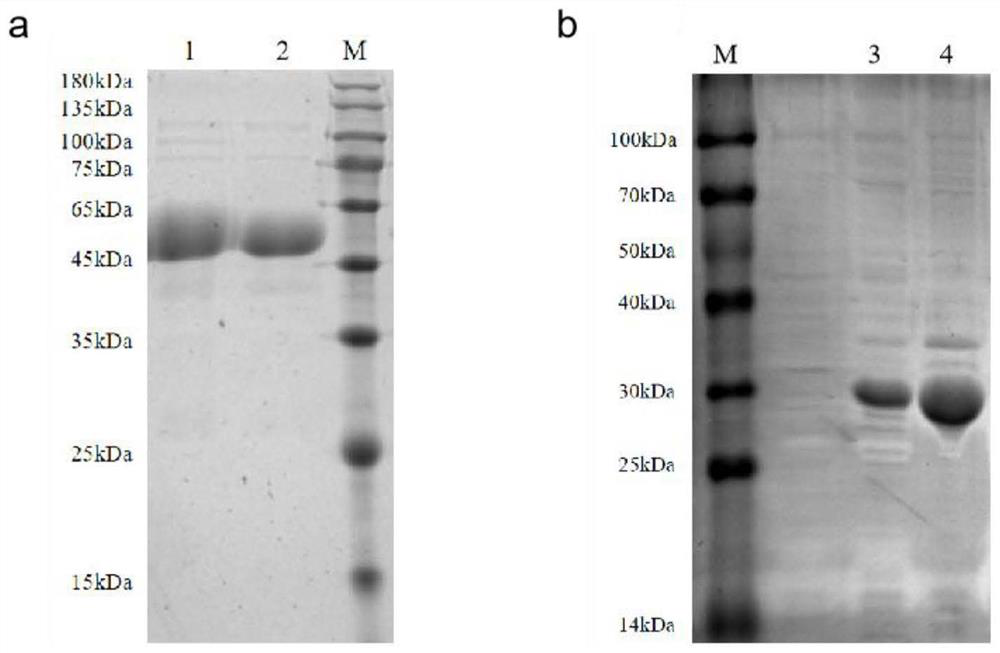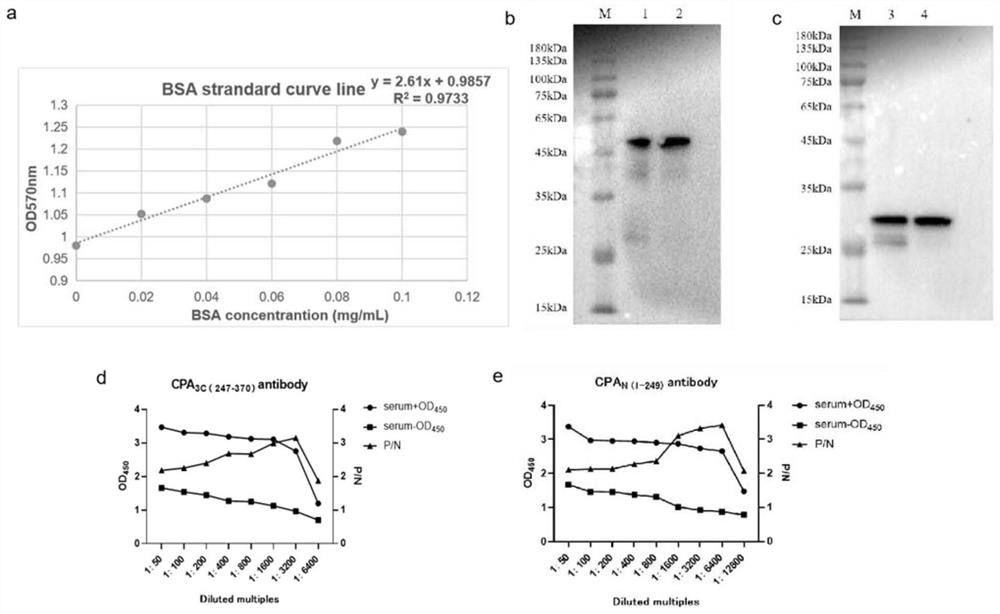Clostridium perfringens alpha toxin visual detection method
A technology for Clostridium perfringens and alpha toxin, which is applied in chemical instruments and methods, biochemical equipment and methods, botanical equipment and methods, etc. Convenient and fast, high sensitivity, good stability
- Summary
- Abstract
- Description
- Claims
- Application Information
AI Technical Summary
Problems solved by technology
Method used
Image
Examples
Embodiment 1
[0041] Embodiment 1: the basic preparation of detection method
[0042] Step 1, type A standard strain (C57-1) was purchased from China Veterinary Drug Inspection Institute. Alpha toxin 4 amino acid mutant plasmid (CPA m4 ), and in alpha toxin (CPA C3 ) C-terminal three-copy tandem prokaryotic expression vector (pET30a) was constructed by Professor Chen Xiaoyun of China Institute of Veterinary Medicine [14,15] .
[0043] Because the site-directed mutagenesis toxin can greatly reduce the toxicity and lethality of CPA, it is convenient for subsequent preparation of non-lethal rabbit serum antibodies.
[0044] We then used the existing α-toxin 4 amino acid mutation plasmid (CPA m4 ) for N-terminal truncation construction, so the constructed expression vector contains two mutation sites (D56G, D130G). Construction of N-terminal expression vector PET30a-CPA of CPA using two primers N , according to Genbank search Clostridium perfringens alpha toxin gene (Genbank accession num...
Embodiment 2
[0049] Embodiment 2: Condition optimization of detection method
[0050] Step 1, determine the optimal coating conditions: the variable is the coating antibody (bound silica microsphere antibody CPA C3 ) concentration and time temperature, other conditions are fixed, the selected toxin concentration is 10LD 50 , (each condition was repeated 3 times) and then observe the fluorescence image by fluorescence microscope, and finally obtain the ratio by gray value analysis. Finally, the optimal coating condition was determined to be 0.1 mg / mL capture antibody, and the silica microspheres were mixed at 25°C for 2 hours. see attached results Figure 4 : Optimum condition for microsphere fluorescence detection experiment; (a) determine optimum antibody coating condition.
[0051] Step 2, determination of optimal blocking conditions: variable is the blocking agent (5% skimmed milk powder or 5% BSA) selected, other conditions are fixed, and the selected toxin concentration is 10LD 50...
Embodiment 3
[0053] Embodiment 3: the establishment of detection method
[0054] Step 1, the concentration gradient dilution of the toxin CPA was carried out, and the undiluted original toxin concentration was initially determined to be 10LD 50 , so we serially dilute it by 2 times to get 10LD 50 , 5LD 50 , 2.5LD 50 , 1.25LD 50 , 0.625LD 50 , three biological repetitions were carried out for each concentration gradient, and the corresponding fluorescence pictures were obtained by fluorescence microscope detection. see attached results Figure 5 , the CPA was serially diluted 10LD 50 , 5LD 50 , 2.5LD 50 , 1.25LD 50 , 0.625LD 50 After detecting the fluorescence intensity, three biological replicates were set for each concentration gradient. It is proved that the stability of the equation is good.
[0055] Step 2, use ImageJ software to analyze the gray value, and finally draw the obtained gray value into a regression curve, regression equation: Y=0.01915X+0.002875 (R 2 = 0.9972)...
PUM
 Login to View More
Login to View More Abstract
Description
Claims
Application Information
 Login to View More
Login to View More - R&D
- Intellectual Property
- Life Sciences
- Materials
- Tech Scout
- Unparalleled Data Quality
- Higher Quality Content
- 60% Fewer Hallucinations
Browse by: Latest US Patents, China's latest patents, Technical Efficacy Thesaurus, Application Domain, Technology Topic, Popular Technical Reports.
© 2025 PatSnap. All rights reserved.Legal|Privacy policy|Modern Slavery Act Transparency Statement|Sitemap|About US| Contact US: help@patsnap.com



